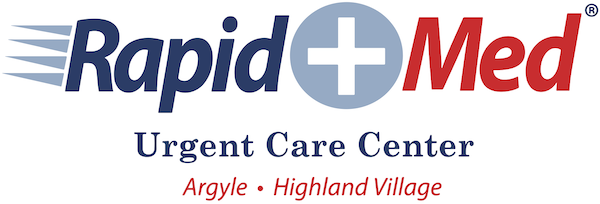Are you an avid runner, dancer, or athlete experiencing pain along the front or inside of your lower legs? You might be dealing with shin splints – a common overuse injury that can put a damper on your active lifestyle. But fear not, because understanding what shin splints are, how to prevent them, and where to seek treatment can help you get back on your feet and back to doing what you love. Rapid Med Urgent Care in Highland Village or Argyle is here to provide expert care for shin splints and help you overcome the pain.
Understanding Shin Splints
 Shin splints, commonly known to doctors and nurses as a medial tibial stress (its a syndrome), are a common condition characterized by (sometimes) intense pain and clear inflammation along the shinbone (tibia), typically on the front or inside of the lower leg. They often occur as a result of repetitive stress or overuse of the muscles, tendons, and bones in the lower leg, particularly during activities that involve running, jumping, or sudden changes in direction.
Shin splints, commonly known to doctors and nurses as a medial tibial stress (its a syndrome), are a common condition characterized by (sometimes) intense pain and clear inflammation along the shinbone (tibia), typically on the front or inside of the lower leg. They often occur as a result of repetitive stress or overuse of the muscles, tendons, and bones in the lower leg, particularly during activities that involve running, jumping, or sudden changes in direction.
Common Causes of Shin Splints:
Several factors can contribute to the development of shin splints, including:
- Overtraining: Increasing the intensity, duration, or frequency of exercise too quickly can put excessive strain on the muscles and bones of the lower leg, leading to shin splints.
- Poor Footwear: Wearing shoes that lack adequate support or cushioning, or that are worn out or improperly fitted, can increase your risk of developing shin splints.
- Biomechanical Issues: Abnormalities in foot structure, gait mechanics, or muscle imbalances can place undue stress on the lower leg, increasing susceptibility to shin splints.
- Hard Surface: Jogging, Running or most exercises on really hard surfaces such as concrete or asphalt can increase the impact on your lower legs and contribute to the development of shin splints.
- Training Errors: Failing to incorporate proper warm-up and cool-down routines, or neglecting strength and flexibility training, can predispose you to shin splints and other overuse injuries.
Prevention Strategies: While shin splints can be frustrating, there are steps you can take to reduce your risk of developing them:
- Gradual Progression: Gradually increase the intensity, duration, and frequency of your workouts to give your muscles and bones time to adapt and strengthen.
- Proper Footwear: Invest in high-quality athletic shoes that provide adequate support, cushioning, and stability for your feet and lower legs. Replace your shoes regularly, especially if they show signs of wear and tear.
- Cross-Training: Incorporate a variety of low-impact activities such as swimming, cycling, or strength training into your exercise routine to reduce the repetitive stress on your lower legs.
- Proper Technique: Pay attention to your running or exercise technique, and avoid overstriding, heel striking, or other biomechanical errors that can increase the risk of shin splints.
- Listen to Your Body: Pay attention to any signs of pain, discomfort, or fatigue in your lower legs, and take appropriate rest breaks or modify your workouts as needed to prevent overuse injuries.
Treatment Options at Rapid Med Urgent Care
If you find yourself experiencing persistent or severe shin splint pain, don’t hesitate to seek treatment at Rapid Med Urgent Care in Highland Village or Argyle.
 Our experienced healthcare providers offer a range of treatment options to help you find relief and get back to your active lifestyle:
Our experienced healthcare providers offer a range of treatment options to help you find relief and get back to your active lifestyle:
- Professional Evaluation: Our team will conduct a thorough examination of your lower legs to assess the severity of your shin splints and identify any contributing factors. We may perform diagnostic tests such as X-rays or MRI scans to rule out other potential causes of your symptoms.
- Pain Management: Shin splints can be painful, but relief is available. Our team can provide medications such as nonsteroidal anti-inflammatory drugs (NSAIDs) or pain relievers to alleviate discomfort and reduce inflammation.
- Rest and Rehabilitation: Rest is often the best initial treatment for shin splints, allowing the inflamed tissues to heal. Our team can provide guidance on activity modification, stretching exercises, and physical therapy to promote healing and prevent recurrence.
- Follow-Up Care: Our team is available for follow-up appointments as needed to monitor your progress, adjust your treatment plan, and ensure that your shin splints are resolving as expected. We’re committed to supporting you throughout your recovery journey and helping you get back to the activities you love.
Don’t let shin splints keep you sidelined from your favorite activities. By following these prevention tips and seeking timely treatment at Rapid Med Urgent Care in Highland Village or Argyle, you can overcome shin splints and get back to living your active, healthy lifestyle. Schedule a visit today and let us help you find relief from shin splint pain!
Schedule a visit today and experience the Rapid Med difference!

